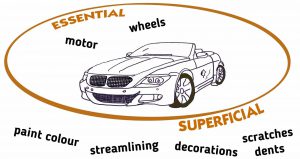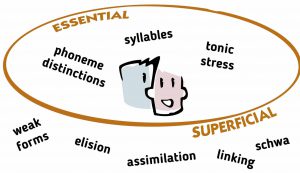
In my previous post, I promised to investigate possible implications a post-ELF perspective for pronunciation teaching, and in this post we will consider the question of what features of phonology we should focus on.
Let me begin with an analogy. If you think of a car, you can probably divide its features into essential and superficial. For example, wheels and a motor are essential (currently, at least). The colour doesn’t matter and is superficial, and the exact body shape probably doesn’t matter much either. There are even features which are accidental such as scratches and dents in the body work.

Imagine now that an alien finds a car floating in space (slightly more likely now Elon Musk has sent one out there). Let’s suppose the aliens set out to make cars of their own. They may have no idea which features are essential and which are superficial or even accidental. Imagine the absurdity of them copying all of these features slavishly, down to incidental scratches!
Where I’m going with this analogy is that there may be a similar absurdity in some of what we traditionally do in pronunciation teaching. In parallel to the car analogy, we could perhaps divide features of English phonology into essential and superficial, and here is an attempt to do just that.

For the Listener’s or Speaker’s Benefit?
Here’s an observation: notice that the essential features are for the benefit of the listener – these features serve to make the intended communication clearer and less ambiguous. Meanwhile, the superficial features are for the benefit of the speaker – they make the message easier and quicker to articulate. Features of connected speech, for example, are like streamlining on a car. The car still moves without the streamlining; speech still makes sense without the features of connected speech.
This observation has implications for pronunciation teaching, especially in relation to the learner’s needs and objectives. Productively, if learners are aiming exclusively for intelligibility, then they should perhaps focus only on the essential features. If on the other hand, they would also like an easier life, in terms of the work they have to do to articulate, then they would also benefit from working on some of the superficial features.
Differentiated Feedback
The quality of the teacher’s feedback probably needs to be different for the two kinds of pronunciation features. For the essential features, feedback needs to be insistent, and we need to find ways to demonstrate to the learners how their message is at risk of being misunderstood. For the superficial features, feedback advice can be more optional, with a socio-cultural flavour – for example, ‘Some speakers of English find it easier to say it this way – give it a try, see if you like it’.
This last point may be made clearer with a concrete example. In my accent, the word today has stress on the second syllable, and the first vowel is reduced to a schwa. I find most learners do not pick up the vowel reduction, preferring to keep a full vowel for the letter ‘o’ – something like the vowel sound in could or even two. This is highly unlikely to cause misunderstanding (providing they don’t also stress the first syllable, making TWO-day, as in ‘a two-day journey’, for example). Consequently, I point out the difference between my own pronunciation of today and my learner’s version in the spirit of socio-cultural comparison rather than correct-versus-incorrect. It’s up to the learners if they want to go along with my vowel reduction or not.
Productive or Receptive Goals?
A final point: the above observations about teaching implications have been concerned with features which we teach for productive purposes. For receptive purposes, learners need to work on both essential and superficial features, since they will find most likely find both in the speech of their future interlocutors. I sometimes ask students to produce features which I intend to be mainly for receptive purposes only because sometimes, trying to produce something is the best way of becoming aware of it receptively.

